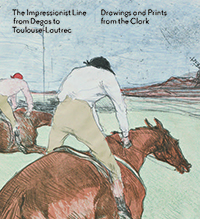
NOVEMBER 5, 2017–JANUARY 7, 2018
PAUL GAUGUIN
Paul Gauguin (French, 1848–1903)
Te Atua (The Gods), from Noa Noa (Fragrant Scent), 1893–94
Color woodcut on paper
Clark Art Institute, 1962.73
In the early 1870s successful financier Paul Gauguin (1848–1903) pursued artistic training while avidly collecting paintings by members of the emergent artist cooperative known as the Impressionists. Gauguin joined the Impressionists in 1879 at the invitation of his friend and mentor Camille Pissarro, submitting his own paintings of rural landscapes, still lifes, and interiors to each group exhibition through 1886, when the collective disbanded. Following a major stock market crash, Gauguin became financially unstable and sought to support himself with his art. This dramatic career change spurred a nomadic existence that carried him from Paris to the city of Rouen in Normandy, the Breton village of Pont-Aven, Arles in the south of France, and Polynesian and Caribbean islands in pursuit of idyllic, unencumbered lifestyle and creative inspiration.
Obsessed with the notion of escaping Europe, which he viewed as in decline, Gauguin hoped to discover a primeval paradise during travels to Martinique (summer 1887), and later, Tahiti (1891–93). Gauguin’s visions of these nations as unfettered, however, contradicted the colonial reality: France controlled both islands and the artist himself benefited from highly visible French administrative services, such as trans-oceanic transportation by steamship. Though disappointed by the reach of western influence, Gauguin’s experiences abroad inspired numerous brightly colored paintings and his first prints. These artworks depict indigenous people (especially women) in tropical landscapes infused with complex iconographies relating to western religion and local mythologies.
Seeking a means of promoting his recent paintings to Parisian audiences, Gauguin followed advice from art dealer Theo van Gogh, Vincent van Gogh’s brother, who encouraged the artist to replicate his work as prints. The resulting series of zincographs—a form of lithography using zinc plates—depicted everyday scenes from rural France and Martinique. Printed on vibrant yellow paper, the set became known as The Volpini Suite, after a Monsieur Volpini who exhibited them to a broad public at his temporary café on the grounds of the 1889 Exposition Universelle. In 1893, following Gauguin’s two-year residency in Tahiti, the artist returned to Paris eager for patronage once more. His first woodcuts, which referenced his experiences in Polynesia, debuted in a small, sparsely attended exhibition held in his studio. These deliberately rough-hewn woodcuts, which were printed somewhat off-register in earthy tones of red, orange, and yellow to yield dark, often dream-like images, later illustrated Gauguin’s autobiographical travel journal titled Noa Noa (Fragrant Scent).
A fully illustrated catalogue, edited by Jay A. Clarke, accompanies the exhibition. The 160-page catalogue includes essays by Mary Weaver Chapin, Jay A. Clarke, Anne Higonnet, Richard Kendall, and Alastair Wright. The catalogue is published by the Clark and distributed by Yale University Press. Call the Museum Store at 413 458 0520 to order.


